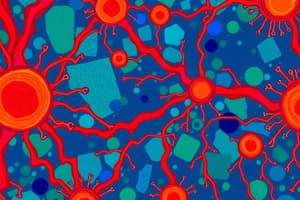Podcast
Questions and Answers
Match the following with their effect on behavior:
Match the following with their effect on behavior:
Oxytocin = Maternal behavior Vasopressin = Sex-related behavioral characteristics Trophic hormones = Nesting activity Antidiuretic hormone = Broodiness
Match the following with their primary role in hormone release:
Match the following with their primary role in hormone release:
Environmental cues = Triggering hormone release Cell-surface receptors = Interaction with peptide and protein hormones Specific receptors = Determining tissue response to hormones Hormone delivery method = Determining selectivity of hormone action
Match the following hormones with their effect on smooth muscle contraction:
Match the following hormones with their effect on smooth muscle contraction:
Oxytocin = Stimulates myoepithelium contraction in mammary gland Secretin = Stimulates pancreatic secretions ADH (vasopressin) = Increases water reabsorption by the kidney Trophic hormones = Can stimulate or inhibit hormone secretion from target organs
What is the major structural group of hormones made from cholesterol?
What is the major structural group of hormones made from cholesterol?
How do paracrine hormones function?
How do paracrine hormones function?
Which type of hormones are synthesized by nervous tissue and carried in the blood to the target tissue?
Which type of hormones are synthesized by nervous tissue and carried in the blood to the target tissue?
Who first recognized homeostasis and its importance in the 19th century?
Who first recognized homeostasis and its importance in the 19th century?
What is the primary function of autocrine hormones?
What is the primary function of autocrine hormones?
Which type of hormone is synthesized from highly active lipids?
Which type of hormone is synthesized from highly active lipids?
What is the primary role of hormones in altering cellular metabolism?
What is the primary role of hormones in altering cellular metabolism?
How do hormones affect enzyme catalytic rates?
How do hormones affect enzyme catalytic rates?
Which process can hormones affect to alter muscle contraction?
Which process can hormones affect to alter muscle contraction?
What is a possible effect of hormones acting as mitogens?
What is a possible effect of hormones acting as mitogens?
How do hormones potentially influence exocrine secretion?
How do hormones potentially influence exocrine secretion?
What distinguishes the effects of hormones from nervous signals?
What distinguishes the effects of hormones from nervous signals?
Which statement best describes the regulation of hormone production by nervous signals?
Which statement best describes the regulation of hormone production by nervous signals?
What is the role of hormones before eliciting a response in the target tissue?
What is the role of hormones before eliciting a response in the target tissue?
In what range are hormones typically present in plasma?
In what range are hormones typically present in plasma?
What does it mean when hormones exhibit 'Permissive Action'?
What does it mean when hormones exhibit 'Permissive Action'?
What is meant by the term 'Synergistic' regarding hormone effects?
What is meant by the term 'Synergistic' regarding hormone effects?
What is the reason for a hypophysectomized winter flounder turning grey?
What is the reason for a hypophysectomized winter flounder turning grey?
How is induced diabetes through alloxan treatment related to endocrine function?
How is induced diabetes through alloxan treatment related to endocrine function?
What effect does cobalt chloride treatment have on the pancreas?
What effect does cobalt chloride treatment have on the pancreas?
How does deafferentation of the vagus nerve impact gastrin secretion?
How does deafferentation of the vagus nerve impact gastrin secretion?
Why are tissues transplanted to an ectopic site, like beneath the kidney capsule?
Why are tissues transplanted to an ectopic site, like beneath the kidney capsule?
What method can be used to check for the presence of a hormone without surgical removal of tissues?
What method can be used to check for the presence of a hormone without surgical removal of tissues?
Which type of cells respond rapidly upon subsequent exposure to the same antigen?
Which type of cells respond rapidly upon subsequent exposure to the same antigen?
What is the main purpose of an adjuvant when given with an antigen in the context of immune response stimulation?
What is the main purpose of an adjuvant when given with an antigen in the context of immune response stimulation?
What is the critical requirement for a substance (Ag) to elicit an antibody response?
What is the critical requirement for a substance (Ag) to elicit an antibody response?
What distinguishes a secondary immune response from a primary immune response?
What distinguishes a secondary immune response from a primary immune response?
What occurs during the primary immune response to an antigen?
What occurs during the primary immune response to an antigen?
What type of antibodies are produced during the immunization process?
What type of antibodies are produced during the immunization process?
Flashcards are hidden until you start studying
Study Notes
Hormone Action Mechanisms
- Two primary mechanisms: Direct gene activation and second-messenger system.
- Direct gene activation is used by steroid hormones and thyroid hormones.
- Protein and peptide hormones utilize the second-messenger system for signal transmission.
Direct Gene Activation
- Steroid hormones can diffuse through the plasma membrane of target cells.
- Once inside the cell, steroid hormones enter the nucleus.
- The hormone binds to a specific protein in the nucleus, forming a hormone-receptor complex.
- This complex interacts with specific DNA sites, leading to the transcription of messenger RNA.
- New proteins are synthesized as a result of gene activation.
Second-Messenger System
- Hormone acts as a first messenger by binding to a membrane receptor.
- Binding activates the receptor and initiates a cascade of reactions, activating an enzyme.
- The enzyme produces a second messenger molecule (e.g., cyclic AMP or cAMP).
- cAMP oversees additional intracellular changes for a specific target cell response.
Stimuli for Hormone Release
- Hormone levels are primarily regulated by negative feedback mechanisms.
- Low hormone levels trigger the release of more hormones until an appropriate level is reached.
- Stimuli for endocrine glands fall into three categories: Hormonal, Humoral, and Neural.
Hormonal Stimuli
- Most common stimulus type for hormone release.
- Endocrine organs activate in response to other hormones.
- Example: Hormones from the hypothalamus stimulate the anterior pituitary.
Humoral Stimuli
- Hormone release is stimulated by changing blood levels of ions and nutrients.
- Humoral refers to body fluids like blood and bile.
- Examples:
- Parathyroid hormone and calcitonin respond to blood calcium levels.
- Insulin is released in response to blood glucose levels.
Neural Stimuli
- Nerve fibers directly stimulate hormone release, mainly influenced by the sympathetic nervous system.
- Example: Sympathetic stimulation leads to the adrenal medulla releasing epinephrine and norepinephrine.
Location and Release of Hormones
- Steroid hormones are not stored; they diffuse out of cells immediately after synthesis.
- Protein and peptide hormones are stored in granules and released upon stimulation.
- Trophic hormones like TSH, FSH, LH, and ACTH stimulate the release of other hormones.
- Hormonal release can be influenced by environmental stimuli, such as light, sound, and temperature.
Metabolism and Excretion of Hormones
- Hormones follow exponential decay kinetics for removal and inactivation.
- The half-life indicates the duration of hormone action in circulation.
- Synthetic hormones are designed with longer half-lives for prolonged effectiveness compared to natural hormones.
- Rapid metabolism and removal of hormones are essential for effective feedback regulation and cellular function management.
Studying That Suits You
Use AI to generate personalized quizzes and flashcards to suit your learning preferences.



